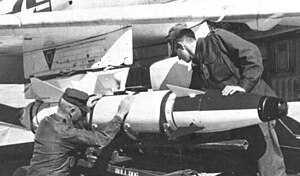AGM-83 Bulldog
| AGM-83 Bulldog | |
|---|---|
 AGM-83 Bulldog | |
| Type | Air-to-ground missile |
| Place of origin | United States |
| Production history | |
| Manufacturer | Texas Instruments |
| Specifications | |
| Mass | 280 kg (620 lb) |
| Length | 3.20 m (10 ft 6 in) |
| Diameter | 0.30 m (12 in) |
| Wingspan | 0.94 m (37 in) |
| Warhead | 113 kg (250 lb) MK 19 blast-fragmentation |
| Engine | Thiokol LR58-RM-4 storable liquid-fuel rocket; 53 kN (12,000 lbf) |
Operational range | 11 km (7 mi) |
| Maximum speed | Mach 1.8 |
The AGM-83 Bulldog was a missile produced by the United States of America.
The missile has its origins in the AGM-12 Bullpup. This missile used a manual guidance system which required the launching aircraft to continue flying towards the target throughout the missile flight time, making it highly vulnerable to counter-attack. The U.S. Navy and Air Force requested a pilot-independent guidance system for the Bullpup which would let the launching aircraft turn away after firing.
In 1970, Texas Instruments was given a Navy contract to create a laser guidance system for the Bullpup. The new missile was designated AGM-83 Bulldog; it was developed in cooperation with the Naval Weapons Center (NWC). The Bulldog was heavily based on the AGM-12B Bullpup A, but used a new 113 kg (250 lb) MK 19 blast-fragmentation warhead. It homed in on the reflection of a laser beam which was projected onto the target by ground troops.
Firing trials of the AGM-83A took place in 1971-1972, with successful results. The Navy planned to get the Bulldog into service by 1974. A version for ground handling training known as the ATM-83A was also planned. However, in 1972 it was decided that the Navy should instead procure a laser-guided version of the Air Force's AGM-65 Maverick, the AGM-65C—which itself was later cancelled in favour of the AGM-65E.
Operators
 United States: The United States Navy cancelled the AGM-83 prior to service entry.
United States: The United States Navy cancelled the AGM-83 prior to service entry.
